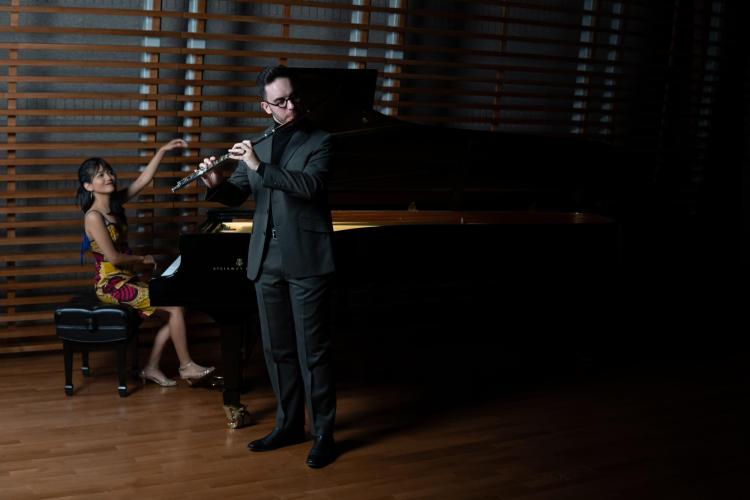Alumnus Kaleb Chesnic expands flute repertoire

Support + inspiration
Chesnic earned his doctorate at the College of Music under the guidance of Professor of Flute Christina Jennings. “She’s a great teacher and thought partner, and an inspiring artist,” he says. “She’s been really supportive and helpful in fleshing out ideas and figuring out how to achieve my goals.”
According to Chesnic, Associate Professor of Music Theory Steven Bruns, Professor of Musicology Carlo Caballero, Associate Professor of Collaborative Piano Margaret McDonald, and String Studies Chair and Associate Professor of Violin Charles Wetherbee—all of whom served on Chesnic’s DMA committee—further played integral roles in the preparation of his recording. Describing McDonald as “an artist of collaboration,” Chesnic says she helped with the transcription process and coached Kato, as well.
He also insists that “this CD would not exist without the artistry and support of Nathália Kato, who has just been amazing the entire time.”
Professor of Harpsichord Robert Hill, too, served as inspiration. “At CU, I did a lot of work with the early music ensemble,” recalls Chesnic. “With Dr. Hill, we played flute sonatas on several concerts. It was amazing to get the opportunity to work with him.”
A persistent idea
Winner of the College of Music’s Ekstrand Competition in 2018, Chesnic knew from the start of his doctoral studies that he wanted to contribute to the flute repertoire, either by commissioning new music or by transcribing existing music.
“There is a period in the flute repertoire that is severely lacking—and it’s not contemporary music. There are a lot of amazing pieces that are being written for flute,” he says. “Because the amount of music from the Romantic era is finite, however, I knew I wanted to expand Romantic era repertoire through transcription.
“I educated myself on Romantic repertoire for many different instruments and came across Grieg’s Violin Sonata No. 3 in C minor, Op. 45. Because this was the third sonata, I knew there had to be two others and I was curious as to why they were not as frequently performed.
“I was really drawn to the symmetry of studying Grieg’s three sonatas, transcribing them during the three years of my degree, and programming and performing them on three recitals.”
Because Chesnic changed the works’ primary instrument, he focused on embodying its spirit as well as possible. “I took lessons with Chas Wetherbee because there were moments when I needed to translate the bowing techniques Grieg wrote into the score,” he explains. “For example, at the opening cadenza of the second second sonata, there are a series of 11 notes marked ‘strepitoso,’ which literally translates to ‘noisy.’ I needed to figure out how I could create this cloud of rosin effect on the flute. It was fun to navigate these techniques with both Chas and Christina.”
Next up, Chesnic looks forward to performing the entire cycle of sonatas back-to-back at the University of Wyoming on April 24. “What I’m most excited about is for flutists and violinists alike to get to know these sonatas on a deep level,” he says. “Violinists are very familiar with the third sonata, but I have personally met only one violinist who has played either of the other two.
“The second sonata is very popular in Norway and in Scandinavia, generally, because it’s more nationally recognizable as Scandinavian music. But flutists have never had the chance to play this music because there has never been a publication of the transcription. I plan on publishing and sharing my transcription of the third sonata.”
In conclusion, Chesnic offers this advice: “When you have a crazy idea and you want to do something that seems not only beyond what you’ve already done, but so far beyond what you’ve already done … just do it! Especially if it’s a persistent idea and something you want to pursue.”
Chesnic lives in Boston, Massachusetts, where he works for Flutistry Boston.


